Mt. Wilson Flooded with Phos-Chek
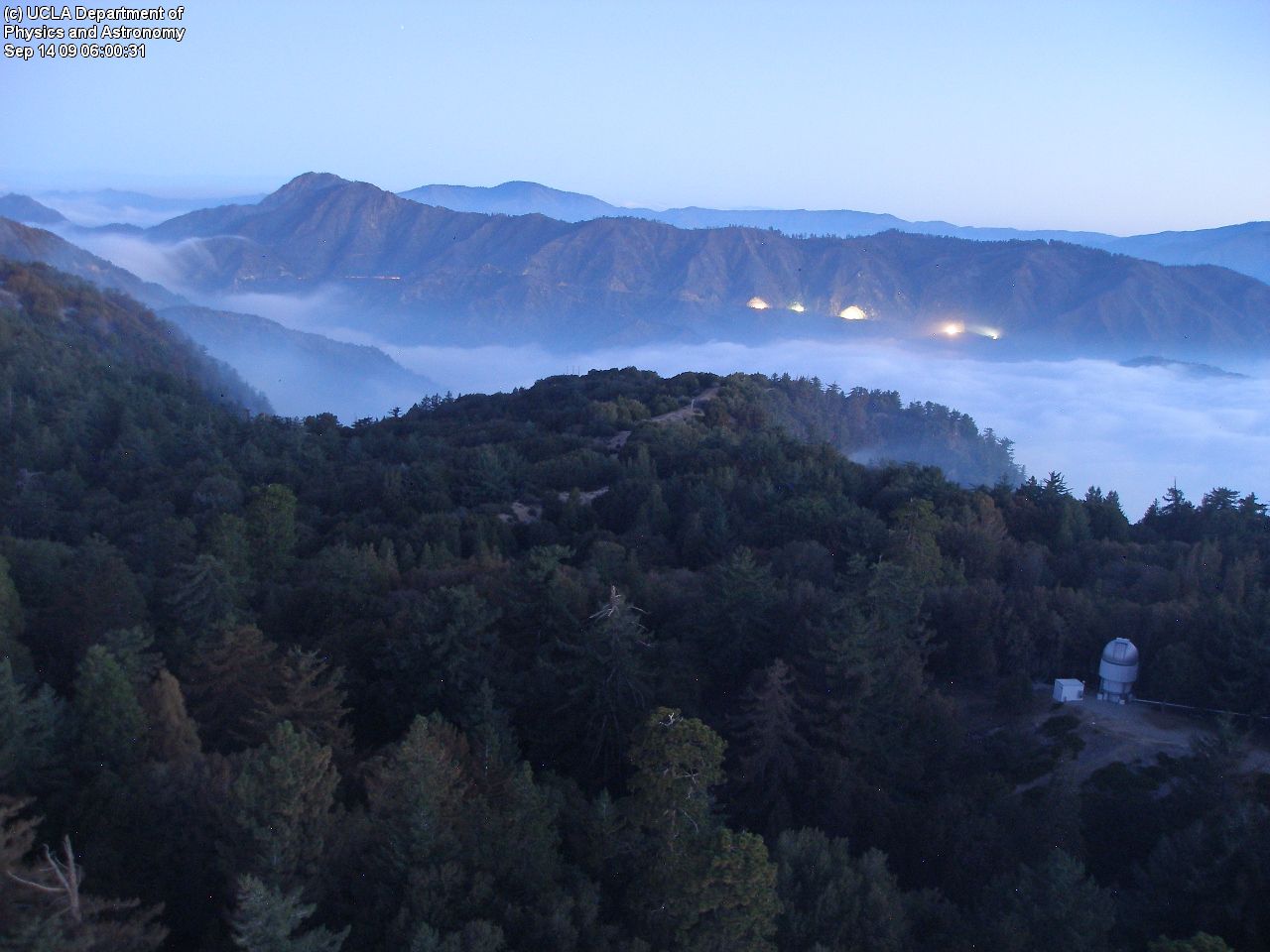
September 14, 2009: LOS ANGELES: The controlled burn on Mt. Wilson was completed over the weekend and deemed a success, but firefighters are preparing to dump tons more fire-retardant gel on the area. (The cover image shows backfire flames near Mt. Wilson around 6 a.m. Pacific.)
“Approximately 10,000 gallons of excess Phos-Chek... mixed in a mobile plant at the Station Fire staging area will be brought to Mount Wilson and sprayed using the hose system already laid out on the grounds so as to mitigate exposure to fire at particularly vulnerable locations around the Observatory,” said Hal McAlister, director of the Mt. Wilson Observatory, located on top of the peak near the city’s TV and FM radio station transmitters.
Dennis Doty reported that Mt. Wilson was “turning every imaginable shade of pink,” with the inundation of Phos-Chek. Doty, a transmitter engineer, has been on the mountain through much of the fire and reported his observations via Bob Gonsett’s CGC Communicator. He noted the explosion over the L.A. area on Saturday, which turned out to be the sonic boom from the landing space shuttle.
McAlister said there are around 50 acres of forest left standing in the area that will probably not be intentionally burnt out. Hot spots remain around the mountain and throughout the Angeles National Forest, where, the 19-day-old Station Fire has consumed 160,557 acres. It is now considered 87 percent contained, with full containment expected by Saturday evening.
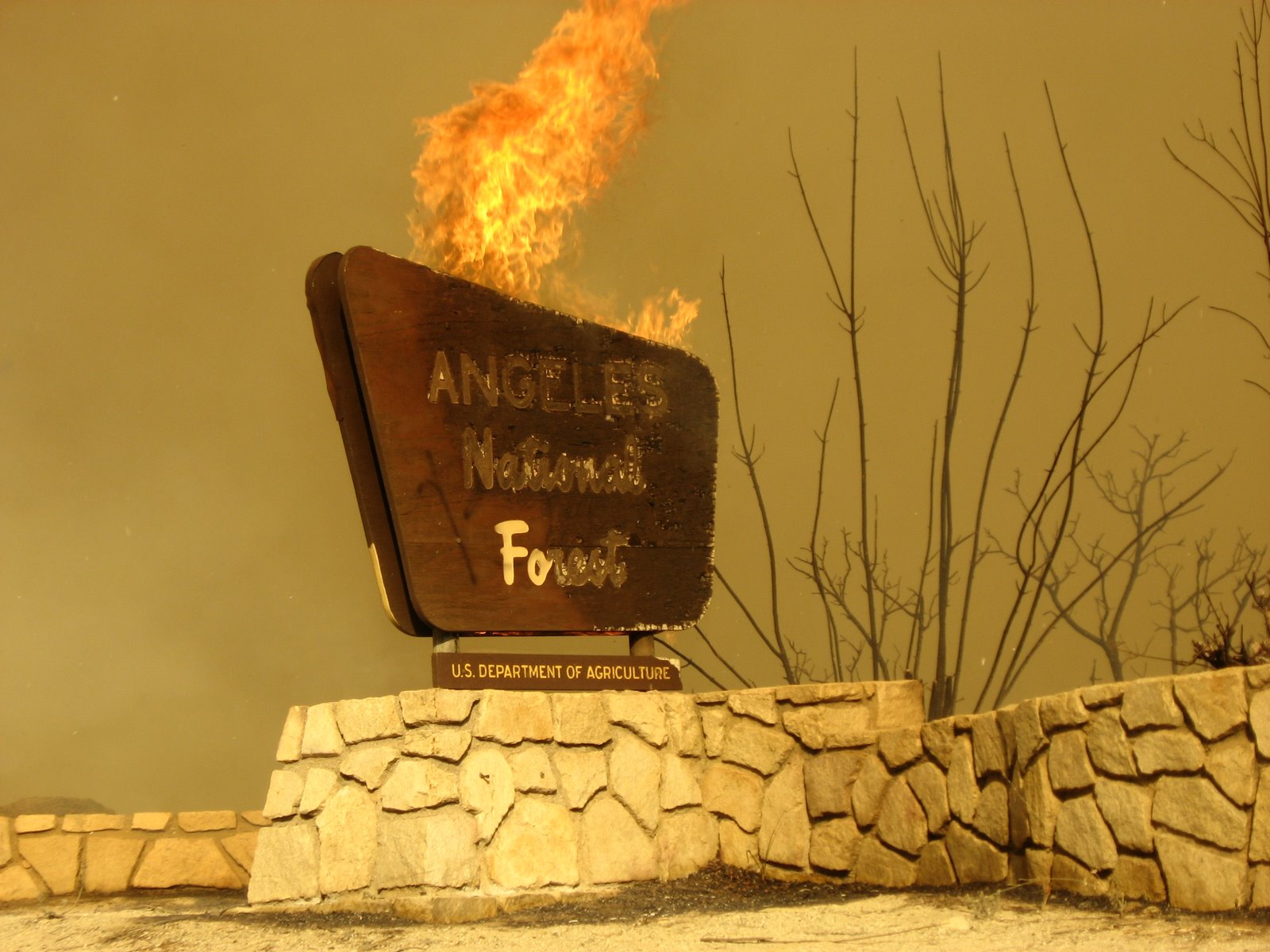
“Those fires will smolder for weeks and it will take a good rain to extinguish any lingering threat from the Station Fire once and for all,” McAlister wrote on the Observatory blog. “The fire hose laid throughout the Observatory will remain in place indefinitely, just in case there is a break out somewhere. I also understand from Dave that a considerable amount of surplus hose will be left with us permanently to supplement the Observatory's fire fighting capability.”
More than 13 miles of hose per day was delivered to firefighters on the front line of the Station Fire, InciWeb said.More than 80 homees were destroyed and two firefighters were killed in the fire, believed to have been started by arsonists. Those firefighters were remembered over the weekend in a memorial ceremony at Dodger Stadium that drew several thousand people, including Vice President Joe Biden and Gov. Arnold Schwarzenegger.
Mt. Wilson Backfires Continue
Officials now consider prevention
September 11, 2009: LOS ANGELES: Hot Shot firefighting crews spent the night on Mt. Wilson to monitor the backfires set there yesterday to clear underbrush that could fuel spot fires. This, according to Hal McAlister, director of the Mt. Wilson Observatory.
“Well over 100 men and women have been involved on the fire line in setting and managing this important back fire. Meanwhile, many more fire fighters are stationed around the Observatory grounds in the unlikely event things go wrong,” McAlister wrote on the Observatory Web site.
The TV and radio transmission facilities on the peak are out of immediate danger. Engineers are being allowed on the mountain, according to Dennis Doty’s regular communiqués with Robert Gonsett, a veteran San Diego RF engineer and publisher of the CGC Communicator.
The Angeles National Forest Station Fire has burned more than 160,000 acres, and is considered 71 percent contained after burning for 16 days. The cost of fighting the fire, attributed to arson, has exceeded $82 million, not considering clean-up and road repair. Two firefighters died early on in the blaze, prompting a homicide investigation.
If not for the resources focused on protecting Mt. Wilson, the City of Los Angeles may very well have lost much of its broadcast communications, a situation to which officials are now giving attention. The Los Angeles Times reported that a Mt. Wilson Fire Safe Council was formed earlier this year. The group secured $200,000 in grants for fire prevention on the mountain, but the money had not yet arrived when the Station Fire was ignited.
Discussions now involve creating a fire buffer zone around the facilities on Mt. Wilson.
Tony Neece, transmitter engineer for KTLA-TV, was quoted in the article, saying that some, but not all, stations had fire plans. “It’s something we are attempting to do. There’s just too much going on in the broadcast industry now,” Neece told the Times.
The fire struck just two months after the digital transition, when TV stations ceased broadcasting in analog. Coverage areas for many stations fell short of expectations, and households across all markets were left without reception of individual stations. The Los Angeles market is the second largest in the nation with nearly 5.7 million TV households. Roughly 800,000 are entirely dependent on broadcast signals for TV reception, according to Nielsen numbers. Those homes would have lost access to much of the nation’s Emergency Alert System had the Mt. Wilson communications facilities been disabled.
Mt. Wilson Backfires Are Burning
15 Days, 70 Percent contained
September 10, 2009: LOS ANGELES: A controlled burn on Mt. Wilson was started at 9 a.m. Pacific. The fire is intended to burn out the think vegetation in the area to reduce the risk of a hot spot re-igniting and spiraling out of control.
“Fred Thompson, Supervisor of the Helenas, told me that the fire will be hand lit down the steep fire break line and then lit by helitorch along the dozer line,” wrote Hal McAlister, director of the Mt. Wilson Observatory.
A similar backfire was successfully completed yesterday east of the mountain where virtually all of the city’s radio transmitters are located. The Angeles National Forest Station Fire, now in its 15th day, continues to be a threat to the area. Although 70 percent contained, growth potential is still considered “extreme.”
“The east flank of the fire remains uncontrolled,” this morning’s InciWeb update stated. “Until a secure line can be completed there is still some potential for the fire to become active in the area of the Highway 2 slop-over of a few days ago between Chile and Mt. Waterman. Hand crews, dozers, and engine crews continue to work on containment from Alder Saddle to Winston Ridge and south to Highway 2 and beyond into the San Gabriel Wilderness.”
Highway 2 is the only main road that transects the forest; the other landmarks are primarily on the eastern front of the fire.
The transmitters on Mt. Wilson have escaped major damage thus far. Engineers have managed to get in and change air-conditioning filters; more major cleaning is expected to be necessary once the fire is safely under control.
There is some concern about power feeds on the mountain. Scott Lacy of Southern California Edison tells Bob Gonsett’s CGC Communicator that a full assessment has yet to be made because of limited access, but the utility is “dealing with thousands of burnt poles...”
Access to Wilson Delayed
Weather conditions halt controlled burn
September 9, 2009LOS ANGELES: TV and radio transmitter staffs awaited word this morning on when they would be allowed to return to Mt. Wilson. A controlled burn in the area, which is still covered in vegetation, remains on hold as well.
Fire officials are keeping a lid on access to Mt. Wilson as the Angeles National Forest Station Fire continues to burn. Winds have shifted the fire front to the north, miles from the transmitters, but the fire perimeter continues to threaten a vast area. Roughly 250 square miles has burned, and wind gusts have caused flames to jump containment boundaries and burn spot fires. This was the case over the weekend when a planned controlled burn on Mt. Wilson had to be postponed.
“The originally planned firing operation from the Mt. Wilson area to the north and northeast was delayed for another day due to a lack of ideal weather conditions. This operation is planned in an easterly and northeasterly direction. The pre-treatment control lines are anchored in and waiting for the burn operation,” public information InciWeb site stated in this morning’s update.
Access is being granted today to Mt. Lukens, a peak west of Mt. Wilson near the edge of the forest, where some telecom towers are located. TV engineers have been establishing secondary transmitters at nearby Verdugo Peak, where several radio towers are located. Lukens is inside the fireline, shown left in red; Verdugo lay outside. Azcar Senior Engineer Randy Hoffner lives near the area and sent the photo below, taken Monday night.
“We live in the Verdugo Hills maybe eight or 10 miles west of Angeles Crest Highway,” Hoffner said in an e-mail. “We saw a lot of burning last week, and the smoke was really bad. We still have smoke, particularly in the morning, but we were never in danger from the fires.”
The Station Fire is in its 14th day, and moving into areas “with no recorded fire history,” InciWeb said. It is considered around 60 percent contained. Full containment is targeted for Sept. 15, but the Pasadena Star-News reported that 45 miles of fire break must be constructed to reach that goal.
The Station Fire is now the 9th largest fire in California since 1933. Nearly 4,700 firefighters are fighting it; more than 20 aircraft have dropped 1.5 million gallons of fire retardant and 2.5 million gallons of water on the flames. The cost of fighting the fire has reached an estimated $57 million. Two firefighters were killed and 75 homes have been lost. The cause of the fire is believed to have been arson. A homicide investigation is under way.
Mt. Wilson Backfires on Hold
Resources needed on northern flank
September 8, 2009LOS ANGELES: Backfires planned for Mt. Wilson over the holiday weekend remain postponed as firefighters needed resources elsewhere to fight the Station Fire, now the largest wildfire in the history of Los Angeles County. More than 160,000 acres have burned--an area more than 12 times the size of Manhattan.
Scores of firefighters have vigorously defended Mt. Wilson since the blaze began 12 days ago on nearby Angeles Crest Highway. The mountain is home to all TV and radio transmitters serving Los Angeles, as well as a famed observatory. Flames reached within a half-mile of the area, but were averted by controlled backfires, breaks and tons of fire retardant and water dropped from aircraft. Another controlled burn was planned for yesterday to clear out remaining dry brush and tinder that could serve as fuel around the structures. The burn was postponed when firefighting aircraft had to be diverted as 30- to 40-mile-per-hour winds pushed the fire north.
All the hoses and control lines are “anchored in and waiting for the burn operation,” according to public information InciWeb site.
A previously planned convoy to return staff to Mt. Wilson over the weekend was cancelled due to safety concerns. A handful of civilians are on the mountain, however. Hal McAlister, director of the Mt. Wilson Observatory, is one.
“Fire hose is now strung all over the Observatory roads all the way to the Monastery, and fire units from numerous jurisdictions are in position just waiting for the process to start. But not today,” he wrote on the observatory blog site Monday afternoon. The Monastery is a dormitory for visiting scientists.
McAlister said the team of Hot Shots--elite firefighters--laid around 20,000 feet of fire hose that will require more than 1,800 gallons of water just to charge. He described the process of the controlled burn: “They will then light the backfire... using drip torches, phosphorus grenades and other hand-lighting devices. The fuel for the drip torches is a 3-to-1 ratio of diesel fuel to unleaded gasoline. Alternately, they will fly in a helicopter with a torch on a long sling that dispenses a napalm-like material. Either way, the fire will be lit methodically and will burn for days before the area is an effective, completed controlled burn and declared ‘black.’”
Only one radio transmitter has gone off the air throughout the 12-day conflagration. Robert Gonsett reported this morning in CGC Communicator that KKLA-FM at 99.5 MHz was down because of a failed “telco program line.”
Just how the fire will affect the transmitter facilities on Mt. Wilson remains to be fully realized. Air-conditioning and air-exchange filters have been replaced, but more cleaning will be required according to Doug Lung, transmitter engineer for NBC and contributor to TV Technology.
“Kerry Cozad [of Dielectric] warned me that some antennas might have problems with soot/carbon/ash,” Lung wrote in an e-mail. “We may not see the problems until there is enough rain or moisture to make it conductive. A good heavy rain might clear the junk off if it wasn’t blown up inside the antennas.
“During the brief visit on Wednesday, our engineers swapped out the air filters on Mount Wilson. The transmitter room and all the equipment smelled heavily of smoke. When we can get contractors up there we’ll have the coils on the cooling systems pressure cleaned.”
Lung NBC engineers have established a backup transmitter site at Verdugo Peak near Glendale, and KCBS-TV was working on one. Verdugo is only about half as high as Mt. Wilson and doesn’t offer near the coverage of the higher peak, but it’s the best available alternative, Lung said.
Two lives have been lost in the Station Fire, nearly 80 homes have been destroyed and around $50 million has been spent so far to fight what officials believe to be an arson fire. The fire is now 56 percent contained, with full containment expected around Sept. 15.
(Cover image from the Mt. Wilson Observatory Web cam captured at 7:20 a.m. Pacific.)
Arson Suspected in Devastating Fire
Forest Service offers convoy to return staff to Mt. Wilson
September 4, 2009LOS ANGELES: The fire that has burned more than 147,000 acres of the Angeles National Forest and threatened the city’s broadcast communications facilities was an act of arson, officials say. Local news outlets indicate that incendiary material was found near the Angeles Crest Highway, and is believed to be the source of the eight-day Station Fire, which claimed the lives of two firefighters. Authorities have launched a homicide investigation.
Containment reached 38 percent yesterday, where it remained today while fire officials conducted infrared mapping to obtain an update, according to The Los Angeles Times. The same article stated that Mt. Wilson “escaped the worst.” Virtually all of L.A.’s TV and radio stations transmit from the top of Mt. Wilson, where a famed historic observatory is also located. Firefighters drenched the mountain with water and fire retardant, set backfires and ripped breaks to protect the area. KNBC-TV did a live remote this morning from the observatory. The area appeared untouched, rife with evergreen.(
Images above and right are from Larry Lopez of Angeles Crest Services. Lopez, who does maintenance on Mt. Wilson, captured the images yesterday, showing the preserved vegetation on the mountain and the devastation of the area leading up to it.)
Engineers began to make return trips to Mt. Wilson Wednesday, and the U.S. Forest Service is offering to escort a convoy up the mountain, possibly this weekend. This, according to Bob Gonsett’s CGC Communicator. Gonsett, a veteran RF engineer who lives in the mountains outside of San Diego, has been a conduit of information for Mt. Wilson engineers, the Forest Service and for regulators keeping tabs on the fire. Details of such a convoy were still being worked out last night, the CGC said.
The Angeles National Forest Station Fire is shaping up to be one of the largest in the history of Los Angeles County. More than 60 homes have been lost, and thousands have been evacuated, though some people are being allowed to return. KTLA-TV is reporting that the cost of fighting the Station Fire has reached $27 million.
Engineers Return to Mt. Wilson
Fires remain a threat
September 3, 2009LOS ANGELES: Backfires, buffers and bombardments of water and fire retardant have spared Mt. Wilson from the Station Fire in the Angeles National Forest, where 144,000 acres have burned in the last seven days. As of this morning, fire officials say the blaze is 38 percent contained, up from 28 percent yesterday.
Larry Lopez returned yesterday to Mt. Wilson, home to more than 40 TV and radio transmitters and a historic observatory.
“The destruction in the Angeles National Forest is too immense to imagine,” wrote Lopez, who works for Angeles Crest Services, a firm that does maintenance on Mt. Wilson. “It looks like a moonscape. I was shocked to see a dust devil cross the canyon where once beautiful evergreen stood.... I have been on this mountain for over 28 years, and I never in my wildest imagination could have seen this devastation occurring.”
(The image above shows the TV transmitters on Mt. Wilson, just to the left and below the red fire line, rendered from Google Maps; the image below shows the full size of the fire area.)
Lopez said he would attempt to go back to Mt. Wilson today. He said the transmitters were not particularly affected by the smoke.
“I will hopefully be returning to the mountain later this morning. I won't know the status of the road blocks this until I get to them. So far, the word is that the transmitters are doing okay. They are all needing their a/c filters changed though, that is a common problem throughout. I do know that the air quality has been a major issue for the people. Living in the Antelope Valley, today is the first day that we've seen the sun in a week. I would walk outside and the sky had a color of an eclipse. My family is suffering from very dry noses, sore throats and two of my dogs are wheezing and coughing once in a while. We have spent a week indoors with the a/c running. It smells like an ashtray outside and looks like it too...ash is on everything.”
The Station Fire popped up a week ago and seemed to be just another brush fire in Southern California, rendered dust dry from extended drought. Then during the weekend, it doubled in size overnight, exploding in 100-foot flames toward foothill cities and Mt. Wilson. The firefighting contingent had grown to more than 4,700 personnel this morning. Containment is not expected until Sept. 15.
The terrain and conditions have made fighting the Station Fire difficult. The rugged mountainous region is sparsely populated with few roads, and covered in tress and brush, some of which hasn’t been burnt back for 40 years. Hot, dry conditions in Southern California served to exacerbate the fire, though temperatures have cooled somewhat in the past two days.
Investigators suspect arson. They were said to be sifting through the ashes of a 20-foot oak near the Angeles Crest Highway yesterday, according to the Los Angeles Times. Two firefighters died in the conflagration and several homes have been lost. The area is being treated as a crime scene.
Though Mt. Wilson has been spared so far, it remains in the path of the fire. The InciWeb public information system posted the following this morning at around 7:30 a.m. Pacific.
“Today the fire continued to move west toward Mount Wilson. Currently there is a large contingent of fire engines, hand crews, and water tenders in place to protect and defend the valuable assets on top of the mountain. Aircraft were also called in to drop retardant on the west slope of Mt. Wilson to slow the fire's progress. Thanks to the hard work done over the past few days Mount Wilson's defensibility has been greatly improved.”
Mt. Wilson Facilities Endure
Backfires and aircraft protect mountaintop so far
Sept. 2, 2009LOS ANGELES: The TV towers and the historic observatory remained intact on top of Mt. Wilson even as flames continued to threaten the area. At midnight Tuesday, firefighters fought off wind gusts that threatened to push the blaze up the 5,710-foot peak, where virtually every TV station and nearly every radio station in the Los Angeles market house transmitter facilities. The mountain is also home to a historic observatory.
Firefighters set backfires and ripped fire breaks while aircraft dropped more than 7,200 gallons of water on the area, the Pasadena Star-News said.
Hal McAlister, director of the Mt. Wilson Observatory, said this morning at 6 a.m. that fire officials told him the peak remained in “good shape,” but said communications were impeded on the mountain because of interference from the powerful TV and radio signals. McAlister was told that a Super Scooper amphibious aircraft had dropped 7,500 gallons of fire retardant on the area.
Despite the continued efforts, Mt. Wilson remains a concern, according to InciWeb.org, an interagency information system.
“Structural protection crews are back in place on Mount Wilson today continuing preparation for its defense,” InciWeb said. “While the mountain top is not yet out of harm’s way, crews are more hopeful about its defense today after additional fuel break construction has been put in place.
As of this morning, the 200-square-mile Station Fire is 22 percent contained after burning nearly 140,000 acres over six days--13,000 overnight. Around 60 homes have burned as the flames move further toward Pasadena and Glendale. More than 4,100 personnel are fighting the fire, the largest in Los Angeles County in more than 100 years.
It’s also been around 40 years since there’s been a fire of significant size in the Angeles Forest, rendering it a tinderbox of crackling dry ceanothus, manzanita, 20-foot scrub oaks and towering Douglas Fir.
The cost of the fire is estimated now at around $21 million, and is not expected to be contained for another two weeks.
(Image of the Station Fire from the Observatory Webcam, midnight, Aug. 31. The Webcam went down yesterday when the phone line it used was reportedly damaged by a backfire. Image of fire-fighting DC-10 over Angeles Forest by Kansas Sebastian
Flames Surround Mt. Wilson
Humidity and cooling temperatures provide relief
Sept. 1, 2009LOS ANGELES: TV signals remained on the air in the nation’s No. 2 market even as 100-foot flames swept through the area where station transmitters are located. Firefighters have been bombarding the area with fire retardant and starting backfires, apparently averting the fire, where the historical Mt. Wilson Observatory is also located.
Hal McAlister is the director of the Observatory. He said that previously evacuated ground crews had returned this morning.
“Some good news,” he wrote at the Observatory Web site. “U.S. Forest Service Fire Dispatch has informed us that as of 9:40 this morning, ground crews were back at the Observatory. As of 8 a. m., air tankers were back in operation. The dispatcher expressed his opinion... that as long as the fire continues to press the mountain from one direction ‘you are going to make it.’
“Furthermore, there is some light rain developing in places in the Los Angeles basin, and there is a possibility for some thunderstorm activity that could lead to dry lightning. The humidity is up and the temperature is a bit lower, so, all in all, things are looking more promising than they have in the last few days.”
The searing temperatures indeed broke this morning after a week of some of the hottest weather in the area this summer. U.S. Forest Service Cmdr. Mike Dietrich told the Los Angeles Times that he was feeling “more optimistic today than I did yesterday.
(In image at left Mt. Wilson is represented by the small orange triangle at the lower right corner of the fire perimeter, illustrated in red. An earlier image of the fire perimeter is included below.)
Local TV stations took heat in more than one way as the fire threatened their transmitter facilities. L.A. County Supervisor Michael Antonovich told the Timesbroadcasters were “negligent” in providing comprehensive coverage of the fire, though NBC and CBS have focused on it for three days in regular newscasts and frequent updates throughout the day. KNBC-TV assistant news director Keith Esparros also noted that the conflagration was initially a small fire far from populous areas. It essentially exploded between Sunday and Monday, doubling in size and moving toward the city.
The Station Fire, raging in the Angeles National Forest northeast of the city, is still only 5 percent contained and not expected to be brought under control for several days, if not two weeks. A total of 122,000 acres has burned--16,000 last night. More than 3,700 firefighters are fighting the blaze, and a Boeing 747 Super Tanker was among the aircraft deployed to drop fire retardant. Fire-fighting aircraft were reported to be grounded at one point today due to poor visibility through the smoke.
Flames Close in on Two Sides of Mt. Wilson
Officials say fire will have to run its course
August 31, 2009LOS ANGELES: Broadcast TV signals were still active here in mid-afternoon as flames surrounded station transmitters sites on Mt. Wilson. The Station Fire had engulfed two sides of Mt. Wilson as of 11:45 a.m. Pacific. A spokesman for the U.S. Forest Service told the Los Angeles Times the fire was “one-half mile north and about one-half mile southwest” of the mountain-top, where more than 20 TV stations have transmitter facilities. The fire previously overran the only road that goes to the site, which is in the rugged Angeles National Forest north of Pasadena.
Firefighters and Forest Service officials clearing brush from around the transmitters for the last few days were pulled off the mountain, the Los Angeles Times said. Fire officials said the plan was to let the fire “take’s its course through the complex.” Flames shooting as high as 100 feet were moving at 15 miles an hour. The towering smoke cloud was easily visible from the beaches more than 30 miles to the west.
In addition to the TV, radio and cell phone towers, Mt. Wilson is home to an observatory housing a 100-inch telescope that was used by Edwin Hubble who identified galaxies beyond the Milky Way. The Mt. Wilson Observatory is also home to the 60-inch Hale telescope. An image below from the UCLA Webcam was captured at 2:01 p.m. Pacific. Smoke surrounded the facility, much as it did earlier in the day, but no flames were apparent.
CBS2 said the fire had burned 105,000 acres by mid-afternoon--20,000 since dawn. More areas were being evacuated as the fire spread into more populated areas, including Sunland and Tujunga. Around 6,600 homes were manditorily evacuated Sunday night. Power had been knocked out to nearly 400 homes.
The Forest Service expanded the closure area around the fire today and said it violators would be subject to fines of between $5,000 and $10,000, or six months in prison.
The Station Fire has claimed two lives so far. Fire Capt. Tedmund “Ted” Hall and Firefighter Specialist Arnaldo “Arnie” Quinones” died last night when their vehicle was overrun by the flames and plummeted from the road.
Five more people were reported trapped in an area unreachable by rescuers. The Pasadena Star-News said four men and one woman in the Gold Creek area of the forest refused to leave after being ordered to evacuate Sunday.
The Station Fire now stands as the largest fire in Los Angeles County’s history since 1897, the Star-News said. Satellite images of the fire are available at NASA’s Earth Observatory site.
Flames Inch Toward TV Towers on Mt. Wilson
City’s RF facilities under siege
August 31, 2009LOS ANGELES: Hundreds of firefighters prepared for a shift change at 6 a.m. today as flames inched up the side of Mt. Wilson, where virtually all of the city’s television transmitters are located.
“If you get television over the air, you could lose our transmission,” said the CBS2 morning anchor Kent Schocknek as the station focused on the flames in the Los Angeles National Forest.
The fire had moved 1.5 miles up the mountain in 24 hours, and was estimated to be less than half a mile from the mountaintop early this morning. TV and radio stations, police and firefighters all have major communications facilities on the mountain overlooking the L.A. basin.
Should the Mt. Wilson TV facilities be consumed, the situation would be similar to what TV stations in New York City dealt with after 9/11, one veteran broadcast engineer said. TV stations there transmitted from the top of the World Trade Centers, and had to scramble to move back to the Empire State Building, where CBS had retained antenna leases. There are no comparable alternative transmitter sites in Los Angeles.
As of Sunday evening, the Station Fire threatening Mt. Wilson had burned nearly 85,000 acres--doubling in size overnight--and was only 5 percent contained. As many as 2,800 firefighters and 350 law enforcement personnel battled the flames. Thousands of homes had been evacuated, and two firefighters died Sunday night when their vehicle was outrun by flames and went off the road in the rugged mountainous region.
A Forest Service official told the Pasadena Star-News that “it’s not a matter of ‘if,’ it’s a matter of when,” the flames reached the transmitters. He said they were “truly in jeopardy.”
The Morris Fire, a separate conflagration east of Mt. Wilson that burned more than 2,100 acres, was reported to be 85 percent contained by Sunday evening.
In the accompanying map above, Mt. Wilson is represented by the small orange triangle at the lower right corner of the fire perimeter, illustrated in red, with arrows indicating the direction of the fire. The Jet Propulsion Laboratory is represented by the green building icon with the small flag. The small flame icon to the right represents the Morris Fire.
-- Deborah D. McAdams
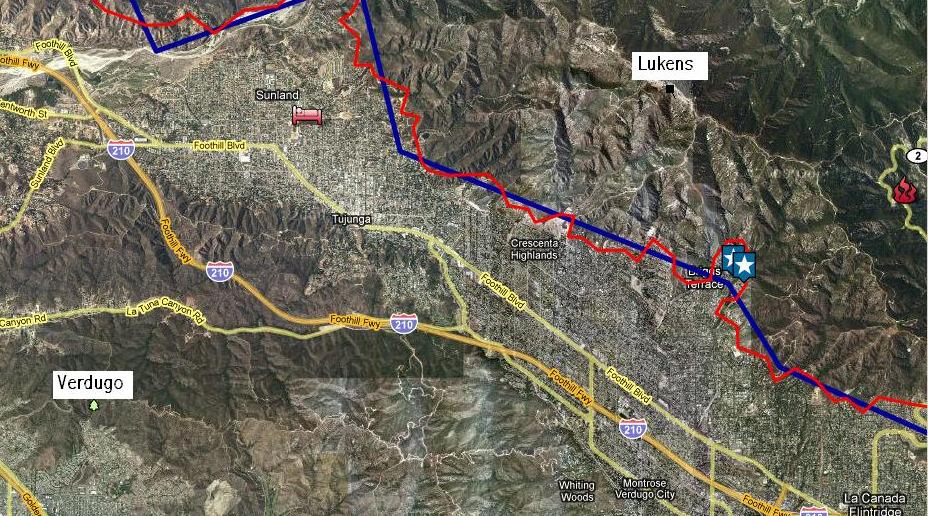
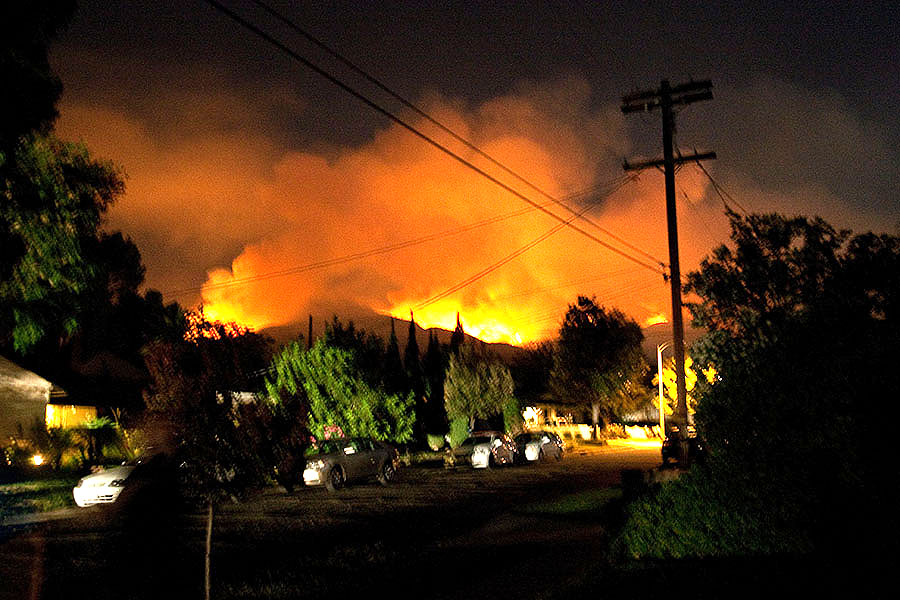
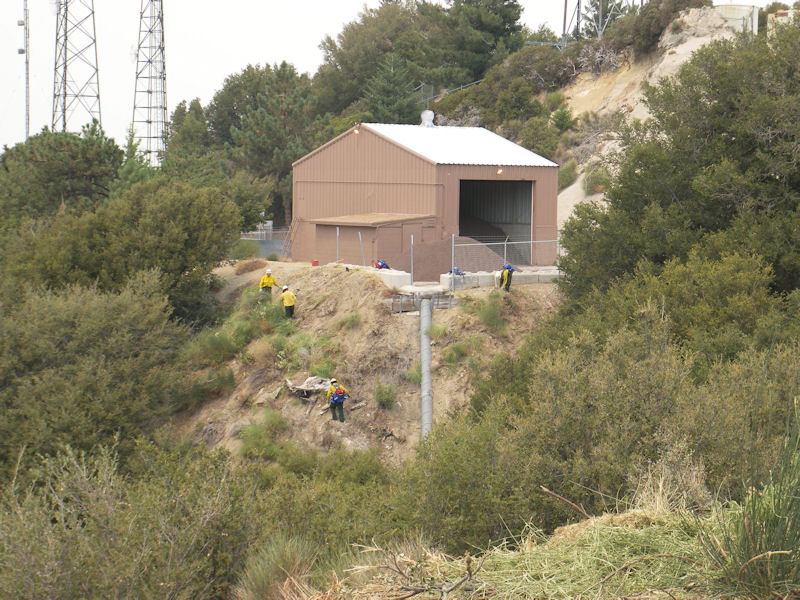
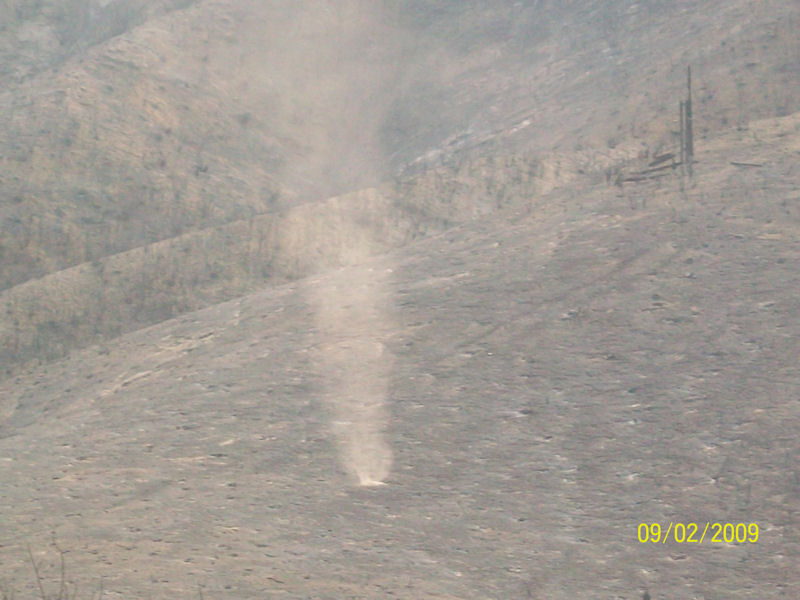
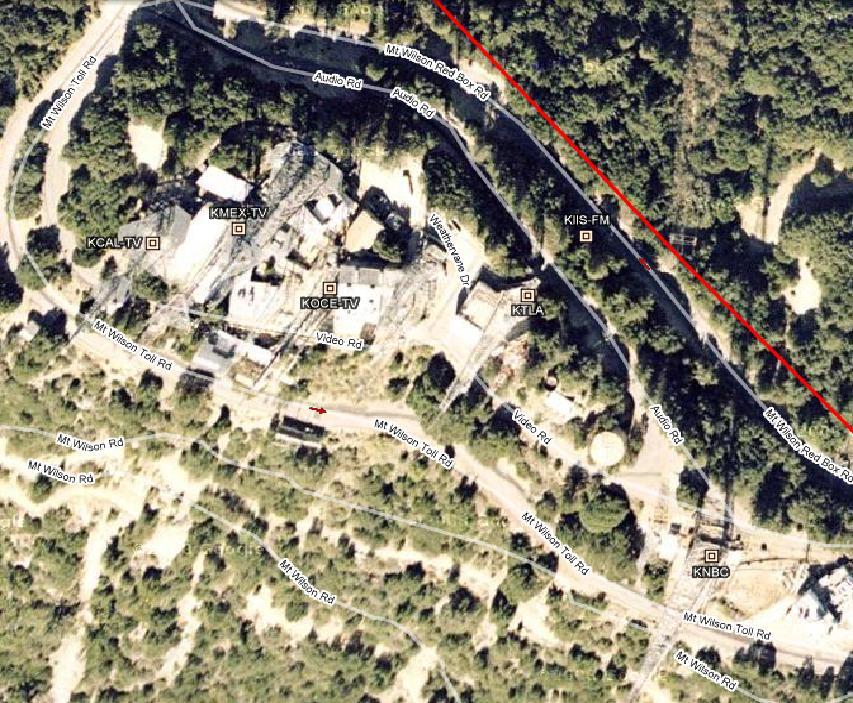

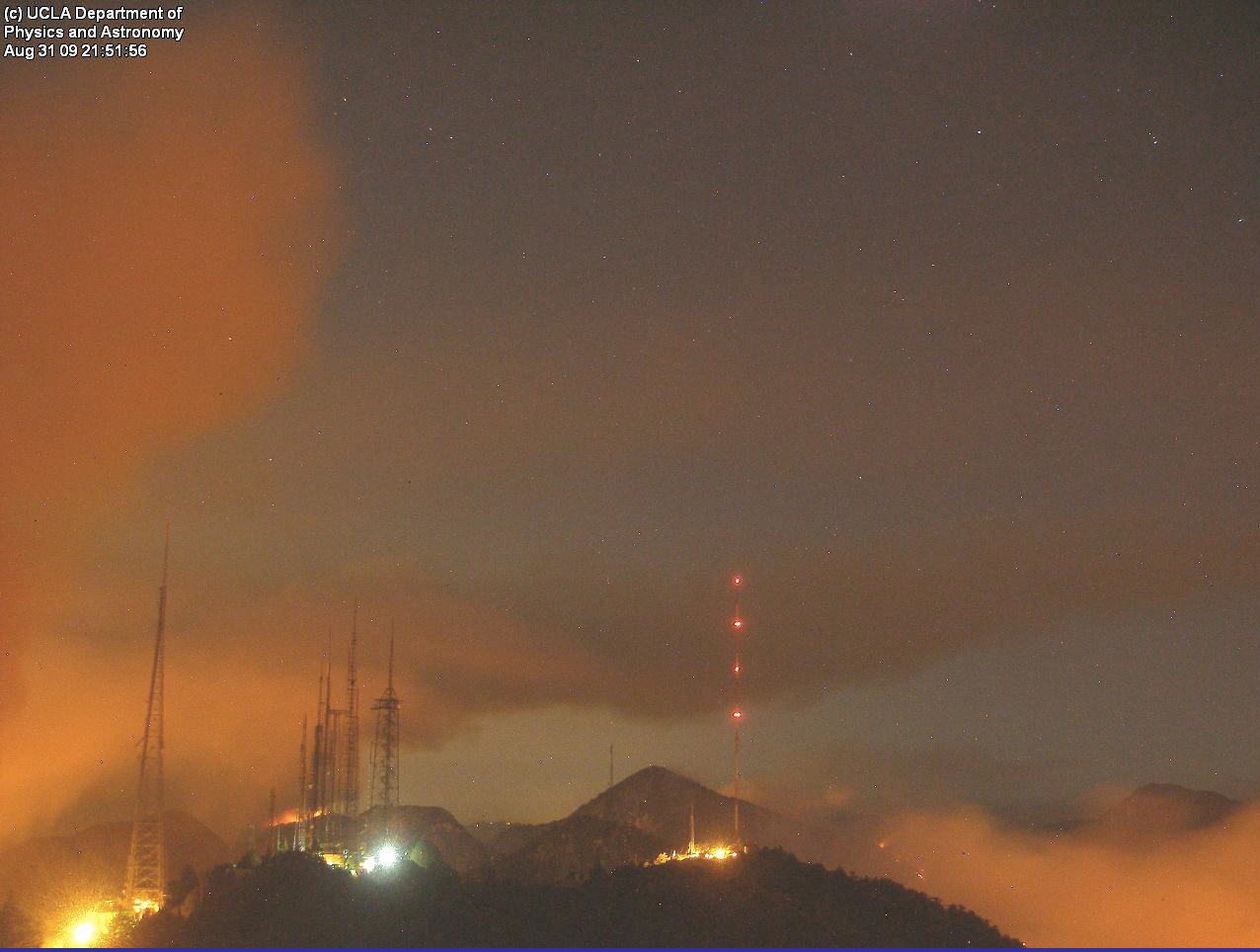
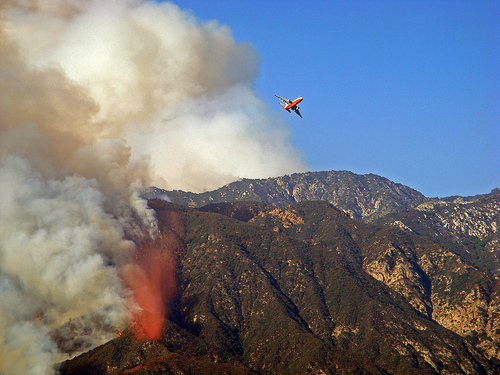
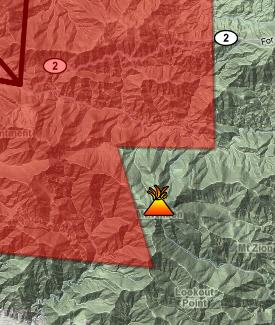
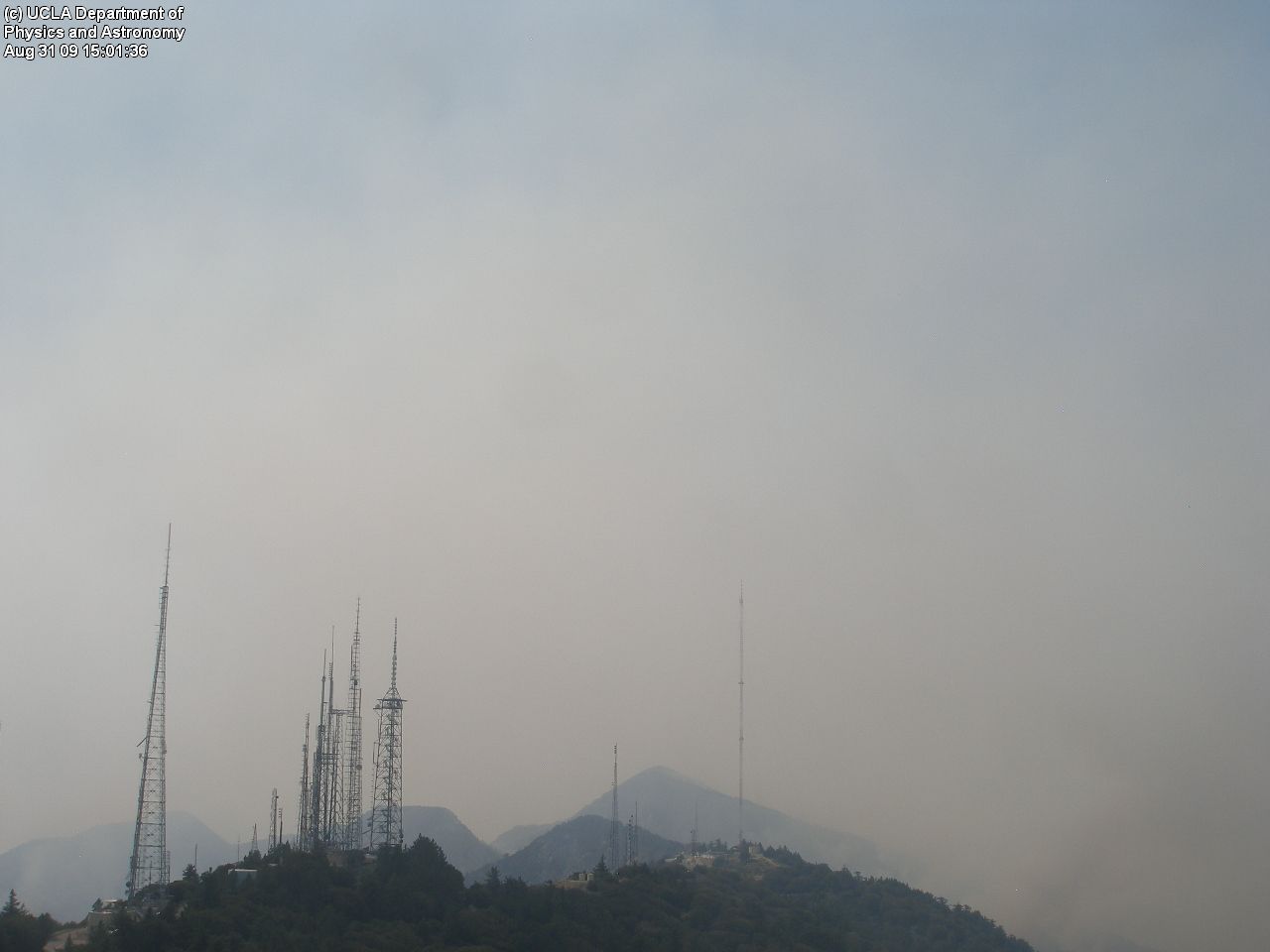
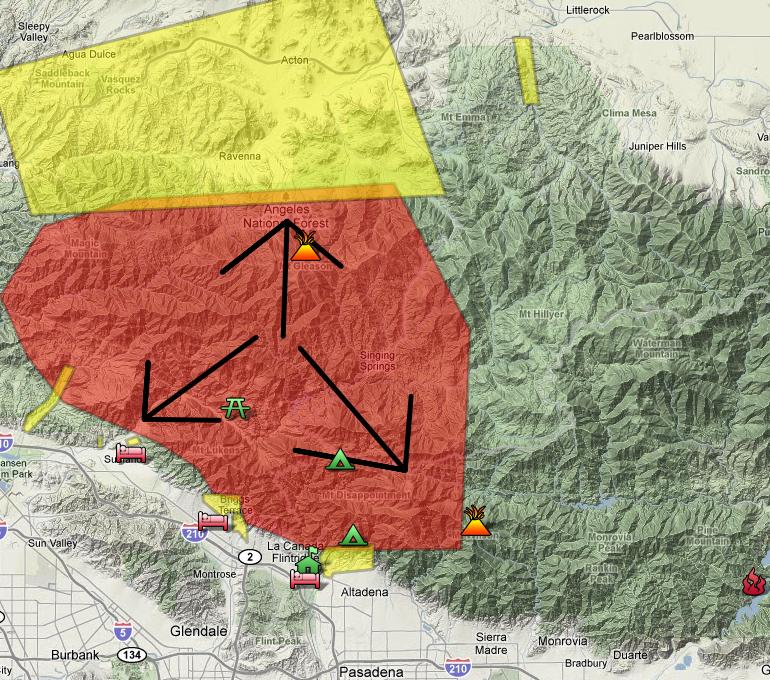
Get the TV Tech Newsletter
The professional video industry's #1 source for news, trends and product and tech information. Sign up below.
